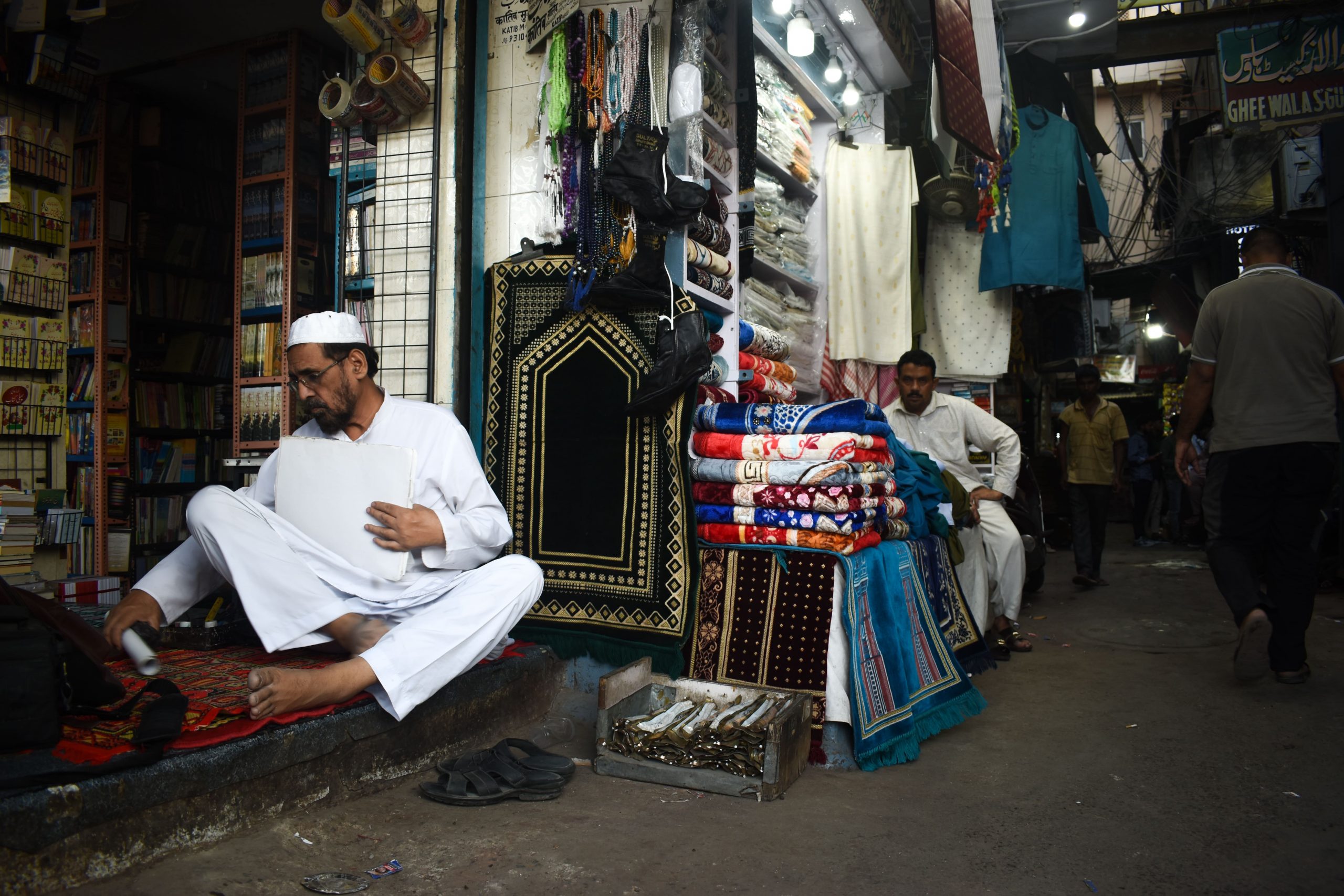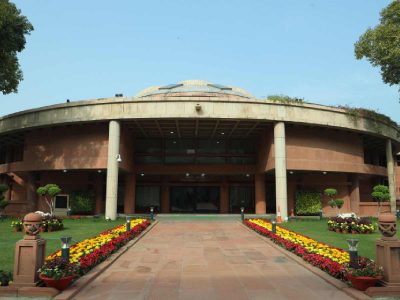Passing through the vibrant lanes of old Delhi’s Urdu Bazaar, adorned with kebab, meat, and cloth shops, one discovers a minuscule store where calligrapher Mohammad Ghalib passionately practices his art. At 60, Ghalib shares insights into the world of calligraphy, occasionally interrupted by well-wishers acknowledging his recent Hajj pilgrimage. “Congratulations on the Hajj pilgrimage, you have always been a loyal person to your profession,” the person said, “but now you should rest”.
Despite suggestions to rest, Ghalib’s dedication to his craft remains unwavering. As Ghalib dodges the statement, he receives a phone call on his smartphone, “I was using a feature phone until I was introduced to this smartphone, but I don’t understand its functioning.” Ghalib does not understand social media well enough to use it for business. Despite past encounters with scams on WhatsApp, where he still receives sporadic orders, Ghalib remains sceptical about leveraging social platform to revive his art. “I simply don’t understand how social media can help in making money and revive the art,” he said. Over the years, his visits to the shop in Urdu Bazaar — once traversed by book lovers due to swarms of bookstores — has decreased due to a decline in commissioned orders.
“Urdu bazaar has changed drastically; earlier it was majorly surrounded by book depots that would provide employment to calligraphers,” he said. Poster making, wedding cards, books, and newspaper designs, among others, were works carried out by calligraphers until technology took over.
“In the initial days, there used to be a lot of work. It was the primary factor that motivated me to come to Delhi from my hometown Saharanpur,” said Ghalib, who writes in Persian, Urdu and Hindi. Ghalib, once optimistic about the art’s future, now sees a decline in employment opportunities and popularity. The younger generation shows little interest in learning calligraphy, and Ghalib attributes the trend to changes in the education system that prioritise English over vernacular languages. Around 42 years ago, he was introduced to the art at an Islamic seminary, Dar-ul-uloom, in Deoband. “Shortage of calligraphers in the market lured people towards the art. Practitioners were employed in newspapers or they wrote books and scripts,” he said.
Ghalib has been quoted as the last calligrapher by multiple news articles. For four years, every day, Ghalib dedicated one hour of his madrassa schedule to learn the art. Initially, Ghalib’s hand would slip while writing, making mistakes every second “days would go by to practise a single letter,” he said. Far from the contours of the internet, Ghalib honed his skills as a disciple of a master of calligraphy in UP.
Due to the belief that calligraphy was at its peak and people were looking out for calligraphers, Ghalib migrated to Delhi in 1982. He was assured employment by an acquaintance, at a weekly newspaper – Quami Awaz. But he was not shortlisted for the role as he had no experience working in newspapers. For the next few weeks, Ghalib was pessimistic about his decision to land in Delhi.
It was in Old Delhi’s Gali Qasim Jan that an opportunity finally came his way. A shop owner who employed several calligraphers gave him paid assignment. “He handed me some material and said “write these down, neat and clean,” Ghalib recalls. But, Ghalib did not hear from the shop owner after he completed his first assignment. This was followed by visits to several newspapers and magazines offices for jobs. His relative, also a calligrapher, would sit in the Urdu Bazaar, introduced him to a bookshop owner in the bazaar. “I worked for 5-6 years at the shop,” Ghalib who writes in Persian, Urdu and Hindi script said. Simultaneously, he also worked on other projects such a book rewriting as an alternative source of income.
Due to less technological advancement “election voters’ list, university question papers books” which were written by calligraphers, were then printed on large scales. With the advancements in technology, it has phased out the usage of calligraphy in the daily life. “Employment has decreased drastically,” said Ghalib, who foresees a bleak future for, but is unaware of the online space where a swarm of calligraphers sell their products online with minimal investments. It is out of curiosity that people visit Ghalib’s shop, “Nobody from the new generation wants to learn the art, as they don’t find any employment avenues,” Ghalib said.
Ghalib also considers the English curriculum in schools and universities a reason that has led to decline of vernacular languages, especially Urdu, “when one doesn’t understand the language, he can’t write that, it is just copy and paste,” he said. “Instead of imparting training for calligraphy, organisations such as Ghalib Academy, Quami Council, Urdu Academy and others are focusing on technology courses,” said Ghalib.
THE ONLINE SPACE
Saiqa Rashid, who hails from Kashmir, and an assistant engineer in the power distribution Department (PDD) of Jammu and Kashmir, showcases her calligraphy art on social media platforms with followers running into tens of thousands.In addition to her day job, Rashid is calligraphy artist with a sizable number of followers on social media. Rashid’s interest in calligraphy grew during her teenage years, when she was introduced to the art form by her madrasa teacher. This helped her to gain steadiness in her hand movement, an essential requirement for the art form. During the Covid-19 pandemic, she took to social media and gradually cultivated an online presence for her art.
According to Rashid, her Unique Selling Point is the fusion of abstract art and calligraphy. She believes that without social media her artistic expression would have died out. “There is no turning back now,” she added. For Rashid, the orders acquired through social media are mostly Quranic verses and names of couples, which intrigue the audience in Kashmir. But across India, calligraphers and their audiences are diverse. To bring artists from different states under one roof, a group of artists in Delhi started an initiative to build a community of calligraphers.
“There is little awareness about calligraphy. If it is not promoted, it will die slowly,” said Abhishek Vardan Singh, executive director of the organization, The Calligraphy Foundation. The foundation seeks to build communities of calligraphers around India, promote their calligraphy scripts and prospects of it as a potential career. Singh is of the view that social media facilitates economic prospects as well as networking with other artists. “Calligraphy is a source of bread and butter for some. Commercial calligraphers earn a decent amount of money, and social media boasts that. Social media also acts as a tool for calligraphers to bond and showcase their work,” said Singh.
THE DILEMMA
While correcting a mistake in an Urdu script sent by a customer, Ghalib said “technology cannot do what our hands can. The intricacies and mistakes in writing can be judged by a trained calligrapher.” Earlier Ghalib focused mostly on calligraphy but now he juggles between various kinds of works such as document translation, getting receipt books printed and sigils readied for customers. “There is work, but it is not necessarily related to calligraphy. I do not know any other calligrapher who is presently working full-time in the market,” said Ghalib.
Singh said that he had seen how social media had helped artists to resurrect their craft. For both- Singh and Rashid- YouTube has been a source to learn new things and trends in calligraphy. “Appreciation on your social media posts by the audience gives you the zeal to work harder,” Rashid said. “It can range from just a comment on your post to buying that product.”
WAY FORWARD
Linking employment to calligraphy, according to Ghalib, is the solution for the survival of the art. “Government should intervene and create platforms and employment posts in their respective departments for calligraphers,” Ghalib said. Singh, meanwhile, says that one
needs to withstand the digital storm to sustain their art. “Technology and rise in social media should be used to popularize the art. Trained traditional calligraphers can also leverage social media to sell their art,” Singh said. The foundation run by him aims to reach amateur calligraphers and harness their potential.
“We have created regional Calli-chapters (to reach out to calligraphers) for various states and UTs to connect with calligraphers who in turn help us to harness the local talent,” Singh said. The foundation will also include calligraphers from Old Delhi. “We aim to work with artists trained in traditional calligraphy and familiarize them with digital technology and social media. If they adapt to social media, they will be able to take their artwork to a larger audience.”





